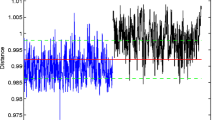Abstract
Radar high-resolution range profile (HRRP) has received intensive attention from the radar automatic target recognition (RATR) community. Usually, since the initial phase of a complex HRRP is strongly sensitive to target position variation, which is referred to as the initial phase sensitivity in this paper, only the amplitude information in the complex HRRP, called the real HRRP in this paper, is used for RATR, whereas the phase information is discarded. However, the remaining phase information except for initial phases in the complex HRRP also contains valuable target discriminant information. This paper proposes a novel feature extraction method for the complex HRRP. The extracted complex feature vector, referred to as the complex feature vector with difference phases, contains the difference phase information between range cells but no initial phase information in the complex HRRP. According to the scattering center model, the physical mechanism of the proposed complex feature vector is similar to that of the real HRRP, except for reserving some phase information independent of the initial phase in the complex HRRP. The recognition algorithms, frame-template establishment methods and preprocessing methods used in the real HRRP-based RATR can also be applied to the proposed complex feature vector-based RATR. Moreover, the components in the complex feature vector with difference phases approximate to follow Gaussian distribution, which make it simple to perform the statistical recognition by such complex feature vector. The recognition experiments based on measured data show that the proposed complex feature vector can obtain better recognition performance than the real HRRP if only the cell interval parameters are properly selected.
Similar content being viewed by others
Reference
Williams R, Westerkamp J, Gross D, et al. Automatic target recognition of time critical moving targets 1D high range resolution (HRR) radar. IEEE Aerosp Electron Syst Mag, 2000, 15(4): 37–43
Kim K T, Seo D K, Kim H T. Efficient radar target recognition using the MUSIC algorithm and invariant feature. IEEE Trans Antennas Propag, 2002, 50(3): 325–337
Liao X J, Runkle P, Carin L. Identification of ground targets from sequential high-range-resolution radar signatures. IEEE Trans Aerosp Electron Syst, 2002, 38(4): 1230–1242
Copsey K, Webb A R. Bayesian Gamma mixture model approach to radar target recognition. IEEE Trans Aerosp Electron Syst, 2003, 39 (4): 1201–1217
Van der Heiden R, Groen F C A. The Box-Cox metric for nearest neighbour classification improvement. Pattern Recog, 1997, 30(2): 273–279
Jacobs S P. Automatic target recognition using high-resolution radar range profiles. Ph. D. Dissertation. Washington D. C.: Washington University, 1999. 35–83
Du L, Liu H W, Bao Z, et al. Radar HRRP target recognition based on higher-order spectra. IEEE Trans Signal Process, 2005, 53(7): 2359–2368
Du L, Liu H W, Bao Z, et al. A two-distribution compounded statistical model for radar HRRP target recognition. IEEE Trans Signal Process, 2006, 54(6): 2226–2238
Liu H W, Ma J H, Bao Z. Analysis of physical mechanism of BOX-COX transformation on improving radar HRRP recognition performance. In: Qu C W, Yi X, Su F, et al., eds. Proceeding of the 9th national radar conference (in Chinese). Yantai: Chinese Institute of Electronics, 2004. 354–357
Liu H W, Bao Z. Radar HRR profiles recognition based on SVM with power-transformed-correlation kernel. In: Yin F L, Wang J, Guo CG, eds. Lecture Notes in Computer Science. Berlin: Springer-Verlag, 2004. 531–536
Ye W. Study of the inverse synthetic aperture radar imaging and motion compensation (in Chinese). Ph. D. Dissertation. Xi’fan: Xidian University, 1996. 12–37
Du L, Liu H W, Bao Z, et al. Radar automatic target recognition using complex high-resolution range profiles. IET Radar, Sonar & Navigation (formerly IEE Proceedings Radar, Sonar and Navigation), 2007, 1(1): 18–26
Xu J Y, Yang J, Peng Y N. A new approach to dual-band polarimetric radar remote sensing image classification, Sci China Ser F-Inf Sci, 2005, 48(6): 747–760
Author information
Authors and Affiliations
Corresponding author
Additional information
Partially supported by the National Natural Science Foundation of China (Grant No. 60302009) and the National Defense Advanced Research Foundation of China (Grant No. 413070501)
Rights and permissions
About this article
Cite this article
Du, L., Liu, H., Bao, Z. et al. Radar automatic target recognition based on feature extraction for complex HRRP. Sci. China Ser. F-Inf. Sci. 51, 1138–1153 (2008). https://doi.org/10.1007/s11432-008-0087-0
Received:
Accepted:
Published:
Issue Date:
DOI: https://doi.org/10.1007/s11432-008-0087-0




